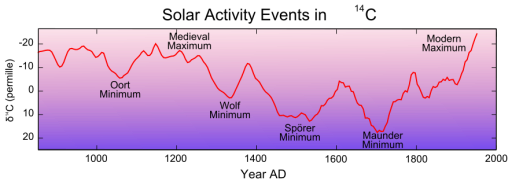The global spanning grand climate system consists of ice, cloud, biology, and ocean and atmospheric circulation. Small changes in solar intensity lead to changes in all these elements which change the distribution of heat and rainfall and the reflectance – and thus the energy budget – of the planet. It is a vastly complex and dynamic system as well as having random elements. Small changes push the system past a threshold at which stage a new climate state emerges as tremendous energies cascade through powerful sub-systems – and this is indeed a quite widely accepted climate science paradigm. Changes in the climate state can be fast and furious – local changes in temperature of as much as 10 degrees C in as little as a decade and shifts in hydrology by a factor of two. Emissions of greenhouse gases and black carbon – or land use change – can theoretically push the system past a climate threshold.
The first chart is a regional reconstruction of temperature – using various methods with variable uncertainty bounds – from the PAGES 2K project. There are regional differences – but what it shows is that there is a general pattern of cooling in the last millennium followed by warming last century.
Source: PAGES 2K Synthesis
The second well known chart is of a carbon dioxide isotope over the past 1000 odd years. The pattern is of a cooling Sun over the millennia – fewer isotopes – and then warming last century. What seems to be the case is that changes in solar intensity are insufficient to cause more than minor changes in temperature directly. Instead – internal mechanisms in the Earth’s climate respond to the small changes in solar intensity and cause in turn a shift in temperature.
Source: Wikipedia
The mechanisms of internal variability is one of the more interesting topics in climate science. Tessa Vance and colleagues reconstructed a ‘Millennial Proxy Record of ENSO and Eastern Australian Rainfall from the Law Dome Ice Core, East Antarctica’. Great masses of air periodically shift between polar and subpolar regions changing climate across the entire globe – and salt deposition at the Law Dome. The chart shows the La Niña phase of the El Niño-Southern Oscillation (ENSO) dominant over most of the past millennium and an increase in El Niño frequency last century. La Niña cool the planet and El Niño warm. The result suggests – inter alia – that looking at rainfall change over 60 years is a little short sighted.
Source: Vance et al 2012
Far more than correlation – there are mechanisms at play. Solar intensity influences mass atmospheric movements which in turn modulates the frequency of ENSO events which warm and cool the planetary atmosphere in physically simple – as well as regionally diverse – ways.
In principle climate is a coupled, nonlinear, chaotic system – but how recurrent (technically ergodic) – are these patterns? The Multi-variate ENSO index of Claus Wolter shows the last 60 years in more detail. It shows intriguing 20 to 30 years periodicities in ENSO frequency – which also show up in the long proxy of Tessa Vance and colleagues. La Niña (blue) dominant to 1976, El Niño to 1998 and La Niña – marginally – again since
Source: NOAA
The pattern – in tandem with increasing El Niño frequency and generally increasing temperatures last century – saw increasing atmospheric temperatures 1944, declining to 1976, increasing to 1998 and not rising since. The multi-decadal pattern suggests that the atmosphere may not warm for a decade or so yet. The millennial pattern suggests the potential for increased La Niña frequency, global cooling and a wetter Australia in the much longer term.
There are intriguing possibilities here. Among then that “… the future evolution of the global mean temperature may hold surprises on both the warm and cold ends of the spectrum due entirely to internal variability that lie well outside the envelope of a steadily increasing global mean temperature.”(1) The very existence of such possibilities implies something else that is almost unthinkable for most. That the belief in climate consensus – and the apocalyptic narratives that emerge – is the most widespread manifestation of the madness of crowds in the history of the world. Global warming scepticism is the other side of the same coin.
We are making a range of changes to the Grand Climate System and the policy responses thus far have been a plan to fail at even the limited objective of reducing carbon dioxide in the atmosphere. What we really need – and seem unlikely to get from the upcoming Paris talks – is much broader goals on climate, hunger, poverty and the environment.
(1) Swanson, K. L., and A. A. Tsonis (2009), Has the climate recently shifted? Geophys. Res. Lett.,36, L06711, doi:10.1029/2008GL037022.




